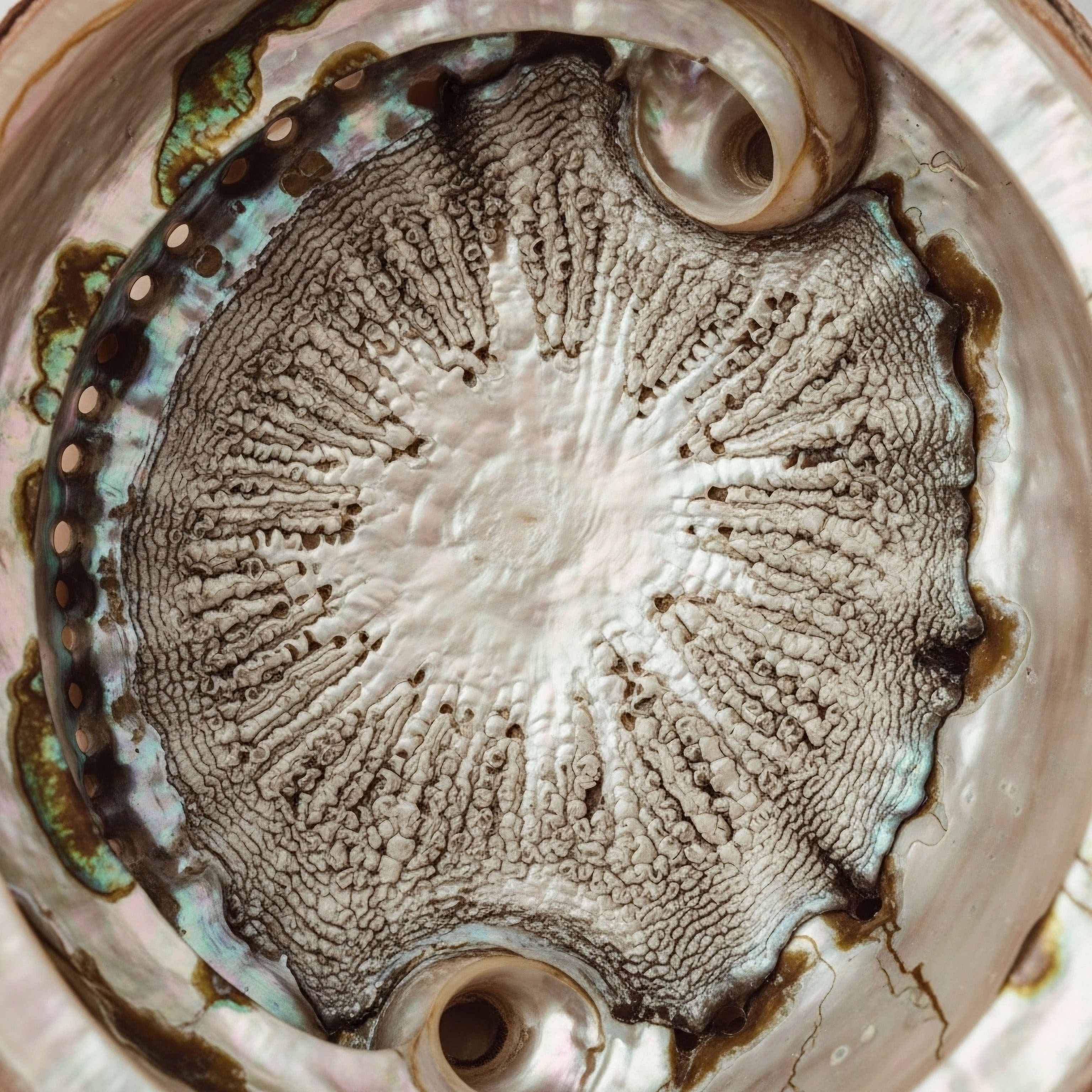

Fundamentals
Have you ever felt that despite consistent effort in your exercise routine and diligent dietary choices, your body’s response seems to defy expectations? Perhaps you notice a slower recovery, persistent fatigue, or a plateau in your progress that feels uniquely stubborn.
This experience is not a personal failing; it reflects the profound, yet often overlooked, interplay between your dietary patterns, your exercise regimen, and the intricate symphony of your internal biological systems. Understanding your own physiology is the first step toward reclaiming vitality and function without compromise.
Our bodies are complex, self-regulating systems, and the messages they send through symptoms are often signals from deeper biological processes. When we consider how dietary choices influence exercise responses, particularly with regard to sex-specific differences, we are truly examining the core of metabolic and hormonal health.
The food we consume provides the raw materials, the fuel, and the signaling molecules that dictate how our bodies adapt to the demands of physical activity. These adaptations are not uniform across all individuals; they are profoundly shaped by biological sex, primarily due to distinct hormonal landscapes.
Your body’s unique responses to diet and exercise are deeply rooted in its hormonal architecture, requiring a personalized approach to wellness.

The Body’s Internal Messaging System
Think of hormones as the body’s sophisticated internal messaging service. These chemical messengers, produced by various glands within the endocrine system, travel through the bloodstream to target cells and tissues, orchestrating a vast array of physiological processes. From regulating metabolism and energy production to influencing mood, sleep, and reproductive function, hormones are central to maintaining internal balance.
When we engage in physical activity, the body’s hormonal milieu shifts dramatically, signaling the need for energy mobilization, tissue repair, and adaptation. Dietary intake directly influences the availability of precursors for hormone synthesis and the sensitivity of cells to these hormonal signals.
For instance, the adrenal glands release cortisol in response to stress, including the physiological stress of exercise. While acute, transient increases in cortisol are a normal part of the exercise response, chronic elevation, potentially exacerbated by inadequate nutrition or excessive training, can lead to undesirable metabolic outcomes.
Similarly, the pancreas releases insulin, a hormone critical for glucose uptake by cells. Dietary carbohydrates significantly influence insulin secretion, which in turn affects how readily muscles can access glucose for fuel during exercise and how effectively they replenish glycogen stores afterward.

Fueling the Human Engine
Our dietary choices provide the essential macronutrients ∞ carbohydrates, proteins, and fats ∞ each serving distinct roles in supporting exercise and recovery. Carbohydrates are the body’s preferred immediate fuel source, stored as glycogen in muscles and the liver. During exercise, especially high-intensity activity, these glycogen stores are rapidly depleted. Adequate carbohydrate intake before, during, and after exercise is crucial for maintaining performance and facilitating recovery.
Proteins are the building blocks of tissues, including muscle. Exercise, particularly resistance training, creates microscopic damage to muscle fibers, which then requires protein for repair and growth. Sufficient protein intake is therefore vital for muscle protein synthesis and adaptation. Dietary fats, while often misunderstood, are a concentrated source of energy and are essential for hormone production, cell membrane integrity, and the absorption of fat-soluble vitamins. They serve as a significant fuel source during lower-intensity, longer-duration exercise.
Macronutrients serve as the fundamental energy sources and building blocks, each playing a distinct role in powering physical activity and facilitating recovery.

Exercise as a Biological Stimulus
Exercise is a powerful stimulus that prompts the body to adapt and become more resilient. The type, intensity, and duration of physical activity all influence the specific physiological responses. For example, endurance exercise primarily challenges the cardiovascular and metabolic systems, requiring sustained energy production. Resistance training, conversely, places mechanical stress on muscles, stimulating pathways related to muscle growth and strength.
The body’s adaptations to exercise are not solely dependent on the training stimulus itself. They are profoundly modulated by the nutritional environment. Without appropriate dietary support, the body’s capacity to recover, repair, and adapt is compromised. This is where the concept of personalized wellness protocols becomes particularly relevant, recognizing that a one-size-fits-all approach to diet and exercise often falls short of individual needs and goals.

Initial Insights into Sex-Specific Responses
Emerging research consistently highlights that men and women exhibit distinct metabolic and hormonal responses to both diet and exercise. These differences are not merely anecdotal; they are rooted in fundamental biological distinctions, primarily driven by the contrasting levels and cyclical patterns of sex steroids, such as estrogen and testosterone.
- Fuel Utilization ∞ During endurance exercise, women tend to oxidize a greater proportion of fat for fuel compared to men, who rely more heavily on carbohydrates and protein. This difference is partially mediated by higher estrogen concentrations in women, which appear to spare glycogen stores.
- Metabolic Adaptations ∞ Studies indicate that men often show greater reductions in total cholesterol and low-density lipoprotein (LDL) in response to dietary and exercise interventions. Women, conversely, frequently exhibit a significant increase in high-density lipoprotein (HDL), a protective factor for cardiovascular health, influenced by estrogen’s role in lipid regulation.
- Appetite Regulation ∞ The hormonal responses governing appetite can also differ. Some research suggests that women’s energy-regulating hormones, such as ghrelin and insulin, may respond to exercise in a manner that could stimulate energy intake more robustly than in men, potentially contributing to differences in body fat loss.
These initial observations underscore the importance of moving beyond generic dietary and exercise recommendations. A deeper understanding of these sex-specific biological mechanisms allows for the creation of truly personalized strategies, optimizing outcomes for each individual’s unique physiological blueprint. Recognizing these fundamental differences validates the experiences of many who have felt their bodies respond differently to conventional advice.


Intermediate
Translating foundational biological concepts into actionable strategies requires a detailed understanding of specific clinical protocols and how dietary choices interact with them. When considering how dietary choices affect sex-specific exercise responses, particularly in the context of optimizing hormonal health, we move into the realm of precise interventions. These interventions, such as Testosterone Replacement Therapy (TRT) or Growth Hormone Peptide Therapy, are not isolated treatments; their efficacy and the body’s adaptive responses are deeply intertwined with nutritional support.

Hormonal Optimization Protocols and Dietary Synergy
Hormonal optimization protocols aim to restore physiological balance, addressing symptoms related to hormonal changes that can significantly impact exercise capacity, recovery, and body composition. For individuals undergoing these protocols, dietary choices become even more critical, acting as a supportive framework that enhances therapeutic outcomes and mitigates potential side effects. The body’s ability to utilize administered hormones or peptides, and to respond favorably to exercise, is highly dependent on the availability of essential nutrients and a balanced metabolic environment.

Testosterone Replacement Therapy for Men
For men experiencing symptoms of low testosterone, such as reduced energy, decreased muscle mass, or impaired recovery from exercise, Testosterone Replacement Therapy (TRT) can be a transformative intervention. A standard protocol often involves weekly intramuscular injections of Testosterone Cypionate. To maintain natural testosterone production and fertility, Gonadorelin is frequently included, administered via subcutaneous injections twice weekly.
Additionally, Anastrozole, an oral tablet taken twice weekly, helps to block the conversion of testosterone to estrogen, managing potential side effects like gynecomastia or water retention. Sometimes, Enclomiphene may be added to support luteinizing hormone (LH) and follicle-stimulating hormone (FSH) levels.
Dietary considerations for men on TRT are paramount. Adequate protein intake is essential to support the increased muscle protein synthesis driven by optimized testosterone levels, maximizing the benefits of resistance training. A focus on healthy fats, including monounsaturated and polyunsaturated fats, supports overall endocrine function and cell membrane health.
Carbohydrate intake should be tailored to activity levels, ensuring sufficient energy for workouts and glycogen replenishment without excessive caloric intake that could lead to unwanted fat gain. Managing body composition through diet is particularly important, as excess adipose tissue can increase aromatization, the conversion of testosterone to estrogen, potentially necessitating higher Anastrozole dosages.
For men on testosterone therapy, precise dietary choices, especially adequate protein and healthy fats, are crucial for maximizing muscle gains and managing estrogen conversion.

Testosterone Replacement Therapy for Women
Women, too, can experience symptoms related to suboptimal testosterone levels, including low libido, mood changes, or difficulty building lean muscle mass. Protocols for women often involve lower doses of Testosterone Cypionate, typically 10 ∞ 20 units (0.1 ∞ 0.2ml) weekly via subcutaneous injection. Progesterone is prescribed based on menopausal status, playing a vital role in hormonal balance, particularly for peri-menopausal and post-menopausal women. Pellet therapy, offering long-acting testosterone, may also be an option, with Anastrozole considered when appropriate to manage estrogen levels.
Dietary strategies for women undergoing testosterone optimization should emphasize nutrient density to support overall hormonal health. Adequate caloric intake is crucial, as chronic energy restriction can negatively impact ovarian function and overall endocrine balance, even with exogenous hormone administration. Women’s bodies tend to favor fat oxidation during exercise, making healthy fats a significant component of their dietary framework.
Protein intake remains vital for muscle repair and growth, particularly as women often require higher relative protein intake to achieve similar anabolic responses compared to men. Micronutrients, such as B vitamins, magnesium, and zinc, are also critical cofactors for hormone synthesis and metabolism.

Post-TRT or Fertility-Stimulating Protocols for Men
For men who discontinue TRT or are seeking to restore natural fertility, specific protocols are employed to reactivate endogenous hormone production. These typically include Gonadorelin, Tamoxifen, and Clomid, with Anastrozole as an optional addition. Gonadorelin stimulates the release of LH and FSH from the pituitary gland, while Tamoxifen and Clomid act as selective estrogen receptor modulators (SERMs) to block estrogen’s negative feedback on the hypothalamus and pituitary, thereby increasing LH and FSH secretion and stimulating testicular testosterone production.
During these protocols, dietary support focuses on optimizing metabolic health to support the body’s natural hormonal recovery. Maintaining a healthy body weight and managing insulin sensitivity through balanced carbohydrate intake and regular physical activity can aid in restoring endogenous hormone production. Specific nutrients like zinc and selenium are known to support testicular function and sperm quality. A diet rich in antioxidants from fruits and vegetables can also help mitigate oxidative stress, which can impact reproductive health.

Growth Hormone Peptide Therapy
Growth Hormone Peptide Therapy targets active adults and athletes seeking benefits such as anti-aging effects, muscle gain, fat loss, and improved sleep quality. Key peptides include Sermorelin, Ipamorelin / CJC-1295, Tesamorelin, Hexarelin, and MK-677. These peptides work by stimulating the body’s own production and release of growth hormone (GH) or by mimicking its actions.
Dietary strategies are integral to maximizing the benefits of peptide therapy. GH and IGF-1 (Insulin-like Growth Factor 1), which is stimulated by GH, are highly anabolic hormones. Therefore, adequate protein intake is crucial to support muscle protein synthesis and recovery.
The timing of nutrient intake, particularly protein and carbohydrates around exercise, can significantly influence the anabolic window and optimize the body’s response to GH-stimulating peptides. For instance, consuming protein and carbohydrates post-workout can enhance recovery and muscle repair, synergizing with the effects of these peptides. Managing blood sugar levels through balanced meals can also optimize GH pulsatility, as high insulin levels can suppress GH release.
Here is a table summarizing key dietary considerations for various hormonal protocols ∞
| Protocol | Primary Goal | Key Dietary Considerations |
|---|---|---|
| TRT Men | Testosterone Optimization, Muscle Gain | Adequate protein for muscle synthesis, healthy fats for hormone production, tailored carbohydrates to activity, body composition management to control aromatization. |
| TRT Women | Hormone Balance, Lean Mass Support | Nutrient-dense diet, sufficient caloric intake, emphasis on healthy fats, higher relative protein intake, micronutrient support (B vitamins, magnesium, zinc). |
| Post-TRT Men | Restoring Endogenous Production, Fertility | Metabolic health optimization, balanced carbohydrate intake, zinc and selenium for testicular function, antioxidant-rich foods. |
| GH Peptide Therapy | Muscle Gain, Fat Loss, Recovery | Ample protein for anabolism, strategic nutrient timing around exercise, blood sugar management to optimize GH pulsatility. |

Other Targeted Peptides and Nutritional Support
Beyond growth hormone-stimulating peptides, other targeted peptides offer specific benefits that can be supported by dietary choices. PT-141, for instance, is used for sexual health. While its action is neurological, overall metabolic health, supported by a balanced diet, contributes to general well-being and can indirectly influence sexual function.
Pentadeca Arginate (PDA) is utilized for tissue repair, healing, and inflammation reduction. For individuals using PDA, dietary components that support tissue repair and reduce inflammation become particularly relevant. This includes adequate protein for collagen synthesis, vitamin C for collagen cross-linking, and omega-3 fatty acids for their anti-inflammatory properties. A diet rich in diverse fruits and vegetables provides antioxidants and phytonutrients that further support healing processes and mitigate systemic inflammation.
Dietary choices serve as a powerful adjunct to peptide therapies, enhancing their efficacy by providing essential building blocks and optimizing the body’s internal environment for repair and adaptation.

The Interplay of Diet, Hormones, and Exercise Adaptation
The body’s adaptive response to exercise is a complex cascade of events, involving signaling pathways, gene expression, and cellular remodeling. Hormones act as crucial orchestrators of these adaptations. Dietary choices provide the substrates and regulatory signals that influence these hormonal responses. For example, the type and timing of carbohydrates consumed can significantly impact insulin sensitivity, which in turn affects how effectively muscles absorb nutrients post-exercise.
Sex-specific differences in metabolic fuel utilization, as discussed in the fundamentals section, mean that dietary recommendations for optimizing exercise performance and body composition may need to be adjusted. Women’s greater reliance on fat oxidation during endurance exercise suggests that a diet providing consistent access to healthy fats might be particularly beneficial for sustained energy. Conversely, men’s higher carbohydrate oxidation during intense exercise points to the importance of robust carbohydrate availability for peak performance and recovery.
Consider the impact of nutrient timing. Consuming protein and carbohydrates around exercise sessions can significantly influence recovery and training adaptations. For men, ensuring adequate carbohydrate intake pre- and post-workout might be critical for maximizing glycogen repletion and performance. For women, while carbohydrates are still vital, the specific ratios and overall caloric intake might need careful consideration to support hormonal balance, especially given observed differences in carbohydrate loading responses.
The precise application of these clinical protocols, combined with a thoughtful, personalized dietary strategy, allows individuals to move beyond generic health advice. It provides a framework for understanding how the body’s internal systems respond to external inputs, enabling a more targeted and effective approach to wellness and performance.


Academic
A deep exploration into how dietary choices affect sex-specific exercise responses requires a rigorous examination of the underlying endocrinology, metabolic pathways, and systems biology. This level of understanding moves beyond general recommendations, delving into the molecular and cellular mechanisms that dictate differential adaptations in male and female physiology. The intricate dance between nutrient signaling, hormonal axes, and genetic predispositions shapes every aspect of exercise performance, recovery, and long-term health outcomes.

The Hypothalamic-Pituitary-Gonadal Axis and Nutritional Influence
The Hypothalamic-Pituitary-Gonadal (HPG) axis serves as the central command center for reproductive and sex hormone regulation. In men, the hypothalamus releases gonadotropin-releasing hormone (GnRH), which stimulates the pituitary to secrete luteinizing hormone (LH) and follicle-stimulating hormone (FSH). LH then acts on the Leydig cells in the testes to produce testosterone, while FSH supports spermatogenesis. In women, the HPG axis similarly controls the ovarian production of estrogen and progesterone, with cyclical fluctuations driving the menstrual cycle.
Nutritional status profoundly influences the functionality of the HPG axis. Chronic energy deficit, particularly in women, can suppress GnRH pulsatility, leading to conditions like functional hypothalamic amenorrhea. This suppression directly impacts estrogen and progesterone production, affecting bone density, metabolic rate, and exercise capacity.
Adequate caloric intake and macronutrient balance are therefore not merely about fueling exercise; they are fundamental to maintaining the integrity of this critical hormonal axis. For men, severe caloric restriction or nutrient deficiencies can also impair testosterone production, impacting muscle anabolism and recovery.

Sex Steroids and Fuel Substrate Utilization
The differential utilization of fuel substrates during exercise is a well-documented sex-specific phenomenon, largely attributed to the influence of sex steroids. Estrogen, particularly 17-beta estradiol, plays a significant role in promoting fat oxidation and sparing glycogen stores in women during endurance exercise. This metabolic shift is mediated by several mechanisms ∞
- Increased Free Fatty Acid (FFA) Availability ∞ Estrogen may enhance lipolysis, increasing the availability of FFAs for oxidation.
- Enhanced FFA Transport and Uptake ∞ It can upregulate proteins involved in FFA transport into muscle cells and mitochondria.
- Mitochondrial Biogenesis and Enzyme Activity ∞ Estrogen may influence mitochondrial density and the activity of enzymes involved in beta-oxidation, the process of fat breakdown for energy.
Conversely, men, with higher testosterone levels, tend to exhibit greater reliance on carbohydrate oxidation during moderate to high-intensity exercise. Testosterone can influence glucose uptake and utilization pathways, contributing to this difference. The implications for dietary strategies are clear ∞ women may benefit from consistent access to healthy fats to support their preferential fat oxidation, while men might require more robust carbohydrate loading strategies for high-intensity or prolonged efforts.

Metabolic Pathways and Dietary Modulation
Beyond fuel selection, dietary choices influence a myriad of metabolic pathways that exhibit sex-specific responses to exercise.

Insulin Sensitivity and Glucose Metabolism
Exercise generally improves insulin sensitivity in both sexes, but the magnitude and mechanisms can differ. Some studies suggest that women may experience greater increases in glucose and insulin levels post-exercise compared to men, who show more pronounced growth hormone responses. This indicates potential sex-specific adaptations in glucose handling and insulin signaling following physical exertion.
Dietary carbohydrate quality and timing become critical here. A diet rich in complex carbohydrates and fiber can help maintain stable blood glucose levels, optimizing insulin sensitivity and supporting efficient glycogen repletion.

Protein Metabolism and Muscle Protein Synthesis
Muscle protein synthesis (MPS) is the process by which muscle tissue is repaired and built, a key adaptation to resistance exercise. While both sexes require adequate protein for MPS, there are indications of sex-specific differences in the anabolic response.
Women may require a relatively higher protein intake per kilogram of body weight to achieve similar rates of MPS compared to men, particularly in the context of energy balance. This suggests that dietary protein recommendations, especially for female athletes, should be carefully considered to ensure optimal muscle adaptation and recovery. The timing of protein intake, particularly within the post-exercise anabolic window, remains a critical factor for both sexes.

Lipid Metabolism and Body Composition
Sex differences in lipid metabolism extend beyond fuel utilization during exercise. Women tend to maintain a higher percentage of body fat than men, even with lower energy intake per kilogram of lean mass. This may be partly due to more efficient fat storage during non-exercising, postprandial periods in women.
Dietary fat quality and quantity therefore play a nuanced role. While healthy fats are essential, excessive intake, particularly of saturated and trans fats, can contribute to dyslipidemia and unfavorable body composition changes, with potentially different impacts on men’s and women’s lipid profiles. For instance, men often show greater reductions in total cholesterol and LDL, while women show significant increases in HDL in response to dietary changes.

The Role of Growth Hormone and Peptides
Growth hormone (GH) and its primary mediator, Insulin-like Growth Factor 1 (IGF-1), are potent anabolic hormones. Exercise is a strong stimulus for GH release, but sex differences exist. Men often exhibit greater post-exercise GH increases compared to women. This difference in endogenous GH response can influence recovery and adaptive processes.
Growth Hormone Peptide Therapy, utilizing agents like Sermorelin or Ipamorelin, aims to augment endogenous GH pulsatility. From an academic perspective, the efficacy of these peptides is tied to the body’s metabolic state. For example, maintaining stable blood glucose levels and avoiding chronic hyperinsulinemia can optimize the natural pulsatile release of GH, synergizing with peptide administration. Dietary protein intake is crucial for providing the amino acid precursors necessary for protein synthesis, which is enhanced by GH and IGF-1.
Consider the complex interaction ∞
- Dietary Protein Intake ∞ Provides amino acids, the building blocks for muscle repair and growth.
- Exercise Stimulus ∞ Creates micro-trauma and signals for adaptation.
- Hormonal Response (e.g. GH, Testosterone, Estrogen) ∞ Orchestrates the anabolic and catabolic processes.
- Peptide Therapy ∞ Modulates hormonal signaling to enhance desired adaptations.
- Sex-Specific Metabolic Pathways ∞ Influence how efficiently nutrients are utilized and how hormones exert their effects.
This interconnectedness means that a diet supporting optimal amino acid availability and metabolic flexibility will enhance the body’s capacity to respond to both exercise and therapeutic interventions.

Clinical Implications and Future Directions
The academic understanding of sex-specific dietary influences on exercise responses has profound clinical implications. It necessitates a shift from generalized nutritional guidelines to highly individualized protocols. For instance, a female endurance athlete might benefit from a dietary approach that prioritizes healthy fats and carefully timed carbohydrates to support her estrogen-mediated fat oxidation and glycogen sparing. A male strength athlete, conversely, might require a higher carbohydrate intake to fuel intense glycolytic efforts and maximize testosterone-driven anabolic pathways.
The integration of advanced diagnostics, such as comprehensive hormone panels and metabolic markers, with detailed dietary assessments, allows for the creation of truly personalized wellness plans. This approach acknowledges the unique biological blueprint of each individual, moving beyond simplistic dietary dogma to a data-driven, systems-biology perspective. The goal is to calibrate the body’s internal machinery through precise nutritional inputs, optimizing its response to physical demands and supporting long-term vitality.
Future research will undoubtedly continue to refine our understanding of these complex interactions, exploring the role of the microbiome, genetic polymorphisms, and chrononutrition in modulating sex-specific exercise adaptations. The continuous evolution of this field promises even more precise and effective strategies for optimizing human health and performance.
Here is a table illustrating the sex-specific metabolic differences during exercise ∞
| Metabolic Parameter | Typical Male Response | Typical Female Response |
|---|---|---|
| Primary Fuel Source (Endurance) | Higher reliance on carbohydrates and protein. | Greater reliance on fat oxidation (glycogen sparing). |
| Post-Exercise Glucose/Insulin | Less pronounced increases. | Greater increases in glucose and insulin. |
| Post-Exercise Growth Hormone | More pronounced increases. | Less pronounced increases. |
| Lipid Profile Changes (Diet/Exercise) | Greater reductions in total cholesterol and LDL. | Significant increase in HDL. |
| Protein Requirements for MPS | May require relatively lower protein per kg body weight for similar MPS. | May require relatively higher protein per kg body weight for similar MPS. |

How Do Hormonal Fluctuations Influence Dietary Needs for Exercise?
Hormonal fluctuations, particularly the cyclical changes in estrogen and progesterone in pre-menopausal women, introduce another layer of complexity to dietary needs for exercise. During the follicular phase (lower estrogen, lower progesterone), women may exhibit metabolic characteristics more akin to men, with a slightly greater reliance on carbohydrate oxidation.
As estrogen rises in the late follicular phase and then both estrogen and progesterone are elevated in the luteal phase, the body’s preference for fat oxidation during exercise becomes more pronounced. This suggests that dietary adjustments, such as slightly increasing healthy fat intake and potentially reducing carbohydrate intake during the luteal phase, could optimize fuel utilization and performance.
For men, while daily hormonal fluctuations are less dramatic, the overall baseline testosterone level significantly impacts metabolic rate and anabolic capacity. Dietary choices that support healthy testosterone levels, such as adequate zinc, vitamin D, and healthy fats, become crucial for optimizing exercise responses. Chronic inflammation or insulin resistance, often driven by poor dietary habits, can negatively impact testosterone production and signaling, thereby diminishing exercise adaptations.

References
- MDPI. Exploring Gender Differences in the Effects of Diet and Physical Activity on Metabolic Parameters.
- ResearchGate. Gender differences in metabolism; nutrition and supplements.
- PubMed Central. Sex Differences in Energy Metabolism Need to Be Considered with Lifestyle Modifications in Humans.
- Korean Journal of Family Medicine. Interactions between exercise, environmental factors, and diet in modulating appetite-regulating hormones ∞ implications for athletes and physically active individuals.
- International Society of Sports Nutrition Position Stand ∞ Nutrient Timing.
- Physiological Genomics. Sex differences in body composition and serum metabolome responses to sustained, physical training suggest enhanced fat oxidation in women compared with men.
- Exercise-Trained Men and Women ∞ Role of Exercise and Diet on Appetite and Energy Intake.
- Gender impacts the post-exercise substrate and endocrine response in trained runners.
- Elite collegiate swimmers do not meet sport nutrition recommendations during heavy training ∞ effects of sex and within-day nutrient timing.

Reflection
Having explored the intricate connections between dietary choices, sex-specific physiology, and exercise responses, you now possess a deeper understanding of your body’s remarkable internal workings. This knowledge is not merely academic; it is a powerful lens through which to view your own health journey. Consider how these insights might reshape your personal approach to nutrition and physical activity. What subtle shifts in your energy levels, recovery patterns, or body composition have you observed that might now make more sense?
The path to optimal vitality is rarely a straight line, nor is it universally defined. It is a deeply personal expedition, guided by an evolving understanding of your unique biological systems. This exploration of hormonal health and metabolic function serves as a foundational step, inviting you to listen more attentively to your body’s signals and to approach your wellness with informed intentionality.
The true power lies in applying this knowledge, not as rigid rules, but as guiding principles for a life lived with greater energy and purpose.



